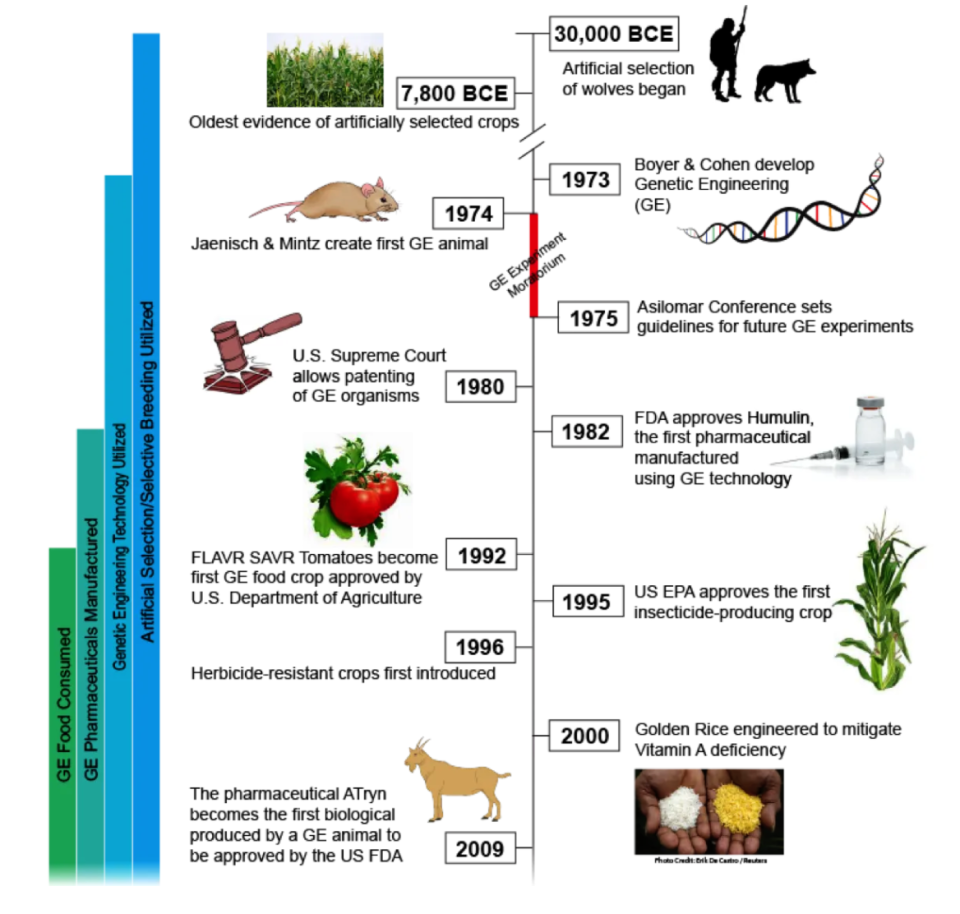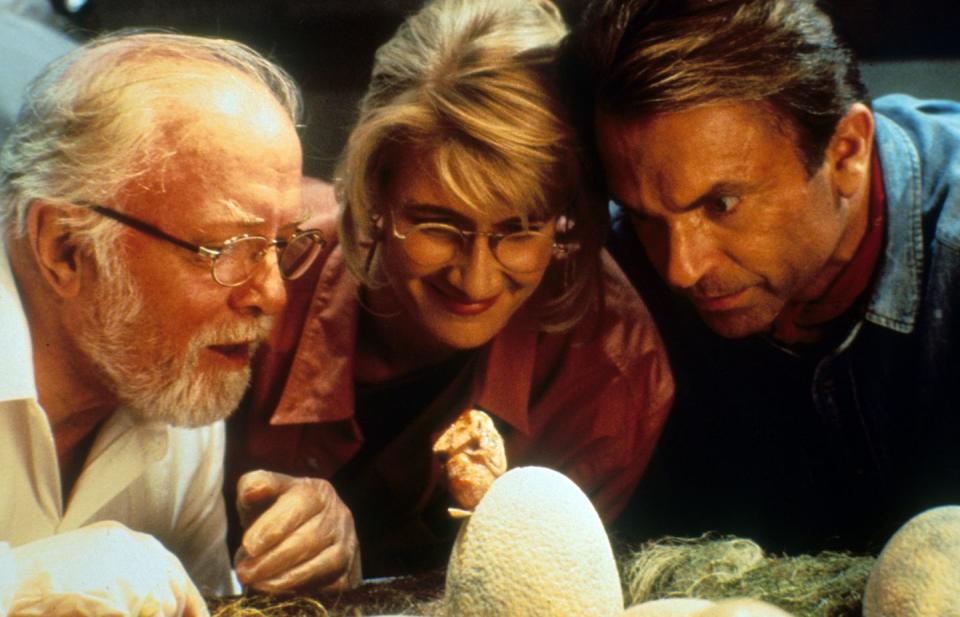Don't Believe What You See in 'Jurassic Park,' Genetic Engineering in Sci-Fi Can Be a Serious Stretch
In the 2002 film Spider-Man, a conspicuous, genetically modified spider bites Peter Parker on the hand, giving him qualities like 20/20 vision and the ability to shoot webs from his wrists. Then there's the 1993 blockbuster Jurassic Park, in which Dr. Grant and Dr. Satler use dinosaur DNA, partially preserved in amber, to bring the likes of velociraptors and brachiosauruses back to life.
DIVE DEEPER. ➡ Read best-in-class tech features and get unlimited access to Pop Mech , starting now.
While divergent in approach and interpretation, both movies use genetic engineering as the underpinning for serious conflict. Since the beginning of modern genetic engineering in the 1970s, sci-fi has grappled with some of the most probing questions about the technology: Is genetic engineering ethical, can it fundamentally improve human life, and most significantly, what are some of the logical worst-case scenarios?
Let's use several classic examples of genetic engineering in sci-fi to separate fact from fiction.
Genetic Engineering 101
Herbert Boyer and Stanley Cohen created the first successful genetically engineered organism in 1973. They devised a biotechnology method that involved cutting out genes from one organism and inserting them into another. In this case, they took a gene that encodes antibiotic resistance and combined it with a separate strain of bacteria, giving the latter antibiotic properties.
Rudolf Jaenisch and Beatrice Mintz formalized the process for animals the following year. In the earliest experiments, that meant combining outside DNA with mouse embryos, according to Science In the News, a group of graduate science communicators at Harvard University.

By 1980, major firms began to rely on genetic engineering. In particular, General Electric created a new kind of bacteria, designed to break down crude oil for use in oil spill cleanups. Because the U.S. Supreme Court allowed GE to patent the bacteria, it created a precedent for companies that wanted to legally own genetically modified organisms, or GMOs. These are plants, animals, or other forms of life that scientists have manipulated to attain certain traits.
Today, one of the most profitable and common use cases for GMOs is in agriculture. The very first experiments using genetically modified food crops dates back to 1987, when Calgene Inc., a Davis, California-based biotech company, introduced its "Flavr Savr tomato." The firm modified the tomatoes to be more firm and to last longer. In a first, the U.S. Department of Agriculture approved the GMO food product for production.
Soybeans are now one of the most common examples of GMO crops in the U.S. According to the U.S. Food and Drug Administration, GMO soybeans made up 94 percent of all soybeans planted in 2018. Like most other genetically modified plants, the soy is used as feed for animals like poultry and livestock, as well as an additive in processed foods.
Beyond that, scientists use genetic engineering to make animals grow larger and develop new pharmaceuticals. CRISPR ("Clusters of Regularly Interspaced Short Palindromic Repeats") is a relatively new tool in genetic engineering that allows scientists to more easily select and alter genes by snipping out strands of DNA.
In some circles, GMOs get a bad rap, with entire conspiracy theories dedicated to the technology. Perhaps some of this can be explained through the lens of science fiction, which examines some of the most damning possibilities if genetic engineering were to go horribly wrong. However, these folks would do well to remember the "fiction" component of the genre.
Fact or Fiction?
Not all sci-fi is created equally—some films and TV shows have more realistic depictions of genetic engineering than others. Here are some of our favorite examples in popular culture, from the most accurate adaptions to some frankly out-there interpretations.
Blade Runner (1982)

What's proposed?
In the year 2019, Los Angeles is thick with pollution and overpopulation. The Replicants—a group of genetically engineered humans, meant to be perfect—are more attractive, smarter, and stronger than their counterparts. However, because they were incubated in the lab, the replicants have a short lifespan of just four years. A special police force hunts down these quasi-humans, identifying them from regular humans with a series of questions of physical tests, known as the Voight-Kampff Test.
How realistic is it?
It's a bit out there. "Although we have been able to identify and manipulate individual genes, we still have a limited understanding of how an entire human emerges from genetic code," Fumiya Iida, a lecturer in mechatronics at the University of Cambridge, wrote in The Independent in 2017. "As such, we don’t know the degree to which we can actually [program] code to design everything we wish."
But there is some degree of realism in the genetic engineering: the kill-switch that causes the Replicants to die after four years is not completely unlike some lab-modified cells. In T-cell therapy, for example, researchers have programmed in the ability to turn the cells on or off if they go rogue.
Star Wars: Episode II - Attack of the Clones (2002)

What's proposed?
On the ocean planet of Kamino, Jedi Knight Obi-Wan Kenobi finds out the Republic has been working on an army of clones, based on the genetic makeup of bounty hunter Jango Fett.
How realistic is it?
Twins are perfect clones of one another, since they have identical genes. But the idea of creating a perfect "twin" in the lab is extremely controversial, and thus, regulatory bodies have blocked this kind of work. The International Society for Stem Cell Research opposes "reproductive" cloning, according to USA Today.
This is in large part because cloning would almost certainly lead to embryos that could not live through a pregnancy, or would at least be born sick or with disabilities. So the Star Wars theory probably wouldn't pan out for a top-tier army.
The Fly (1986)

What's proposed?
In his lab, scientist Seth Brundle has a set of teleportation pods that can move inanimate objects, but drastically mutilate live tissue in animals. After some tinkering, he discovers the machines only create synthetic versions of the object in question, rather than truly recreate the object itself. He tries teleporting himself, only to enter the machine with a housefly. Over time, Brundle starts to see increased sexual stamina and strength, eventually realizing he's fused himself with a fly at the genetic level.
How realistic is it?
More than you think! It turns out humans share about 70 percent of their DNA with the common housefly. "The genes that we share with them are responsible for embryonic development," DNA expert Erica Zahnle told the Chicago Tribune in 2017.
Still, that doesn't mean scientists can necessarily combine humans and flies. It's problematic at the cellular level because humans have 23 pairs of chromosomes, and flies only have six. What's happening in The Fly is more like a viral infection than a viable example of genetic engineering: a fly virus invades the human cell and makes copies of itself. Because there's no splicing or sharing of genes, it wouldn't lead to the gruesome creature Jeff Goldblum becomes.
Jurassic Park (1993)

What's proposed?
Scientists working on a Costa Rican island have come up with a way to bring dinosaurs back to life in a bid to create a theme park. After locating dinosaur DNA inside mosquitoes that were preserved in amber, the researchers combined the partly damaged genetic material with frog DNA. All of the animals were made female to avoid non-test tube breeding.
How realistic is it?
Some of the film's science talk is based in reality, but the applications are, at best, like stretching the truth. For one thing, amber is great at preserving organic materials, but not for 65 million years back to the age of dinosaurs. DNA sequences long enough to be usable and readable for cloning purposes probably can’t survive more than 1.5 million years, according to recent research.
"We can find fragments of DNA [in dinosaur fossils], but not enough of a genome to activate it," Mark Norell, Chair and Macaulay Curator in the American Museum of Natural History's Division of Paleontology, told Popular Mechanics in 2018. "The chances of finding a whole genome is nearly impossible."
Spider-Man (2002)

What's proposed?
During a school field trip to Columbia University's science department, a blue and red spider bites Peter Parker on the hand. It turns out this specimen is one of 15 genetically modified arachnids that scientists created from the synthesized RNA from three natural species of spider. Long story short: Parker ends up with super powers, like the ability to build webs and swing from skyscrapers.
How realistic is it?
Not very, according to a May 2002 article in Genome News Network. "The mechanism in the movie is pure fantasy," Jonathan Coddington, then a research scientist at the National Museum of Natural History, told the news source. Because spider venom contains mostly globular proteins (a type of spherical proteins including hemoglobin and insulin), the transfer of genetic material from spider to human could only occur if a viral parasite were carrying all of the spider's most incredible genes.
Annihilation
What's proposed?
After a meteor lands inside a lighthouse along the southern coast of the U.S., the government creates a restricted area around it, known as Area X. Anyone who enters this dangerous zone called "The Shimmer" dies. Mutated plants and animals abound, including an albino alligator with teeth like a shark, and a bear that screams with the human voice of its last meal. It turns out The Shimmer is refracting plant and animal DNA, leading to mutations.
How realistic is it?
The lines between species are, as the title suggests, annihilated. This isn't completely unrealistic, considering scientists have introduced advanced chimeras in the last few years, including a mouse with 4 percent human DNA. Meanwhile, the forces in The Shimmer that cause organic DNA to scramble are actually found in nature. Known as horizontal gene transfer, this process is the uptake of DNA from one organism into the cells of another.
"The first organism’s DNA is incorporated into the new organisms’ chromosome and then actually functions, changing the properties of the receiving organism," Jeffrey Way and Pamela Silver—two scientists at Harvard's Wyss Institute for Biologically Inspired Engineering—wrote in Sloan Science & Film after the movie debuted. Still, some of the most prevalent examples of horizontal gene transfer include the formation of mitochondria and chloroplasts.
In other words, this is totally rare and won't lead to a horrifying human-bear anytime soon.
You Might Also Like

